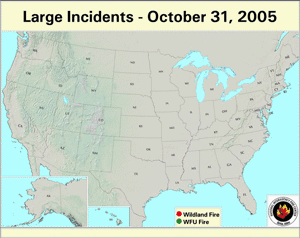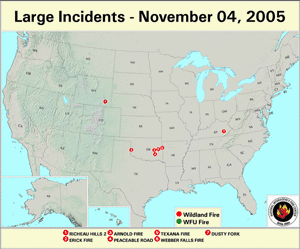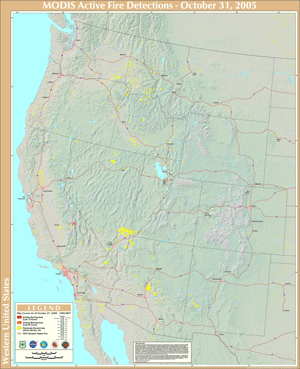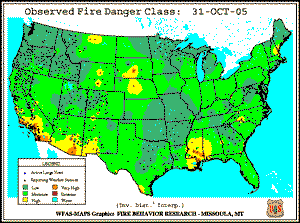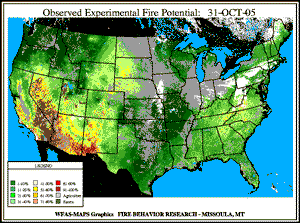Wildfire activity diminished across the U.S. during October, as the remaining large fires in the West and Rocky Mountain regions were suppressed. However, several large fires developed in the Great Plains in early November due to dry conditions in the central and southern Plains.
Typically, fire activity moves from the Pacific Northwest southward to the Southwest as the Polar jet stream shifts south during autumn. However, above normal precipitation has been observed at the beginnning of the western wet season inhibiting large fire development over the past month.
As reported by the National Interagency Fire Center, over 8.3 million acres have burned across the U.S. by the end of October, which at present ranks the 2005 season as the second worst since 1960 for total acreage burned. Currently the 2000 fire season remains the record year for the U.S. with over 8.4 million acres burned.
Alaska had its second consecutive year with widespread wildfire activity, as over 4.4 million acres have burned this year across the state. As of the end of October 2005 over 3.9 million acres have burned across the remainder of the U.S..
| As of November 4, 2005 | Nationwide Number of Fires | Nationwide Number of Acres Burned |
|---|---|---|
| 2005 | 57,933 | 8,318,527 |
| 2004 | 77,534 | 6,790,692 |
| 2003 | 56,085 | 3,726,826 |
| 10–year Average | 73,554 | 5,488,906 |
Dead fuel moisture levels across the western U.S. and High Plains were dry during October. In particular, fine fuel moisture levels (i.e., 10–hour fuels) remained below 5% across most western states during the past month, with the exception of the Pacific Northwest.
Medium to larger fuels (i.e., the 31 October 100–hr and 31 October 1000–hr fuel moistures) were moderately dry at the end of October, especially across the Southwest and Great Basin areas.
The Keetch–Byram Drought Index (KBDI), a widely used index for fire risk, had the largest potential for wildland fire activity in the contiguous U.S. across parts of northern and central California.
For further information on drought conditions across the U.S. go to the October drought summary page.
 NOAA's National Centers for Environmental Information
NOAA's National Centers for Environmental Information
